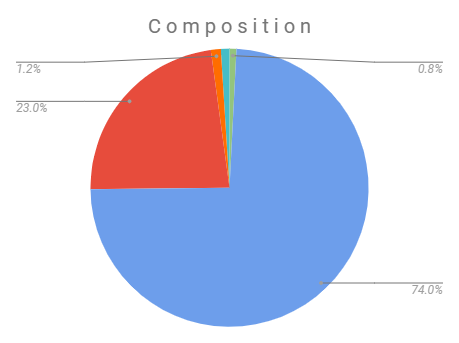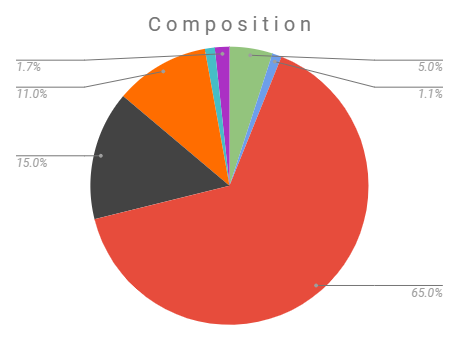Quick question what is the moons temprature (1 = Earth)
And the radii in earth radii?
Quick question what is the moons temprature (1 = Earth)
And the radii in earth radii?
65F average in the starting continent

Red = O2 (23)
Blue = N2 (79)
Orangeish = Ar (1.15)
Green = H2O (0.8)
Teal = CO2 (1)
Yellow = H2S (0.00002 too small to be seen)
Rest of the atmosphere is trace gasses (H, He and H2 is too fast to be held by the moon)
Does this work as a atmosphere @willow
(Also you forgot the silicia storage and what was the roll for wetland for cyeana)
what did you use to make that pie chart?
the hydrogen sulfide should be more abundant.
no you rolled a 3 and the area on the dice chart for that is nothing happens
3
Alright and for your information Designing Earth-like Atmospheres - YouTube (you kinda understand it after 3 wacthes and screwing around with the gasses)
@Cha hydrogen should make up the entirety of the exosphere due to the moon’s earthlike mass but some of the hydrogen occasionally gets pulled off by the pull of one of the other moons.
there should also be 5% methane as it is extremely far from it’s star.
It’s the entire atmosphere

Purple = CO2 (1.7)
Red = N2 (65)
Black = O2 (15)
Orangeish = H2S (11)
Green = CH4 (5)
Teal = Ar (1.15)
Blue = H2O vapour (1.1)
(H, H2 and He is to fast for the moon to hold which means early in the planets life they managed to escaped the planet unless bonded with another element)
Rest is trace gasses @willow
that seems good so it shall be the atmosphere
Question if a area has enough mana intakers (animals and plants which take up mana) can they create a vacuum?
only if there is a glyph preventing mana from entering the area
@everyone round 18 has started since i finished rolling for all of the organisms
@Cha you do not need to @ me in every comment that you use to talk to me as i have this thread on my watched list so i get a notification for every comment in this thread. please only @ me if you are trying to make it clear that you are talking to me after a sentence or paragraph talking to someone else.
name: draculus octopodus
attempted mutations: dopamine, bioluminescence, hemocyanin vacuoles for S2/H2S transportation, polyphorus gill things, kinetic distortion field, bio-hydraulics.
attempted modules: heart, Bacterial defense fluid gland.
attempted castes: aerial, water.
modify modules: muscle: add actin, myosin, tropomyosin, troponin. HGT pilus: lower rigidity, nerves to tell brain to release dopamine when mechanoreceptors activate, contractile macro-vacuole with tube to the exit of the pilus for more efficient compound transfer.
description: a very adaptable octopedal lizard that can survive in many places including but not limited to: space, the entire atmosphere, any body of water above 10C, and a bit closer than the habitable zone for humans around a star. they also reproduce primarily by releasing a cloud of viruses from their tails into the water or crawling inside the mouth of a polyphorus and releasing a cloud of viruses into it along with several faux viruses and junk RNA strands to trick the CRISPR that the polyphorus use but can reproduce by releasing a semi-spherical half-frustule filled with gametes for another draculus to combine with one of theirs.
new habitat: lower planetary orbit
engulf organism: hibcorver ninberbrif, parva cyenea *2, parva merius *3.
diet: literally everything that exists excluding members of their own species
name: polyphorus hexapodus
attempted mutations: cephalization, vocalization chamber, better eyes, sleep cycle, melatonin, social behaviors.
attempted specializations: skin, bone.
modify specialization: muscle: add neurons to make muscles react all at once.
new habitat: inland wastes
diet: every organism it can find that does not have bumps that glow purple on it’s front
template
name:
attempted mutations:
description:
new habitat:
diet:
thing to add to your template:
attempted modules:
attempted castes:
attempted specializations:
engulf organism:
modify module:
modify caste:
modify specialization:
Question can I add a third split in the species given a mutation has appeared that could form it’s own verison of the species?
if you keep track of all the changes in the atmosphere due to biological processes then yes
if you will do so then please put your email address so i can add you as an editor on the document
also the star will only last 12 more rounds
Alright shouldn’t be too hard given it’s almost equilibrium so it should barely change and already on the document so you should be able to add already.
alright.
please submit your 3 mutation sheets and your email address so i can add you as an editor
name: Parva cyenea attempted mutations:
Fixing the mucilage toxins,
burrowing (young for when turning into adults),
cephalization (young),
Increased fecundity,
Hibernation (stopping anything involving using photosynthesis during the 6 months of constant darkness when going behind the gas giant)
description: A purple mat with their young all around them in the water with the adults toxins having been neutralised by their own body they spew tons of non toxic mucilage to defend them self causing no death but can deter some predators which can’t be bothered by the amount of mucilage. Their leaves provide a small safe heaven for some very small young as the “satellite leaf” cover the young inside as well making it harder for predators to take it with the pilus in the middle of the leaves
new habitat: wetland
diet: Same
attempted specializations: Silica storage (again) modify specialization: Leaves able to multiply (Once they reach 1 diameter they start growing another leaf cell and form a larger “satellite leaf”) (edited)
name: Parva Venator attempted mutations:
Compound eyes able to see basic shapes (without the blur),
fixing the blood vessels, leaf stop appearing all together on the species,
cephalization and stabilise the chitin
description: Venator looks almost like merius except it segmented and able to communicate between itself with flashes of light allowing them to do basic hunting strategies if they can’t hunt on their own or inform if danger is near as they can change colour of the light.
new habitat: none
diet: Smaller plankton and the rest is the same (and no photosynthesis) attempted specializations: bristle tentacles (to sweep up the abundant zooplankton and other floating plankton)
modify specialization: increased cell sized for storage
name: Parva Kineto attempted mutations:
stabilise chitin shell,
Internal gill sac (right under the backside mucilage sac you can take this as a mp to a as),
compound eyes devolving (They just stop being on this creature entirely),
fix the blood vessel and retractable “legs”
description: Kineto has gone through a very hard turn moving rarely as they gain a good portion of energy from the waters movement as well taking in it’s cousin Cyenea waste which is spew out H2S or sulfieds as it metabolism require with it also being purple alongside Venator as the pigment exist in their entire body and not just their leaves anymore.
new habitat: Scorched coast
diet: Vibrations and same as Merius before the split.
attempted specializations: Air seeds
modify specialization: Kinetofimbria moved to 3 pairs of tentacles (which is also elongated) and storage to increase in size allowing the species to survive without wind or external forces for a while
(Anything wrong just point it out)
please hit enter between some of those. i made the mutation sheet have them for a reason. so i can actually read them.
also i still need your email address to be able to add you as an editor to the document so you can keep track of the atmospheric compounds in the most convenient place
@Cha can you at least use the PMs to give me your email address so i can add you as an editor for the document
done
(extremely long filler text)
Alright so round 17th and 18th atmosphere is done (CH4 isn’t changed as nothing uses it) is that all or?
i meant also for the rounds before now but it’s fine for now